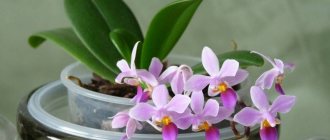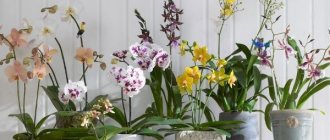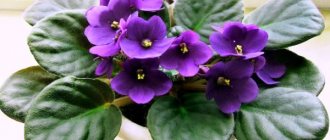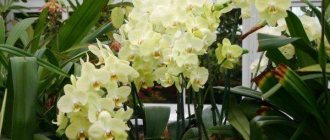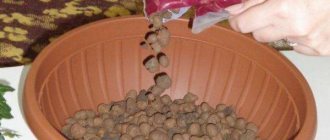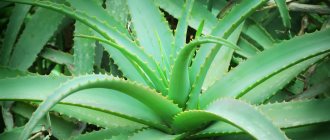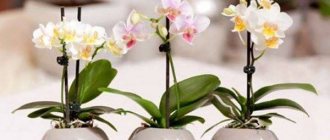The orchid flower is one of the beautiful and unique representatives of the green world. You probably won’t find a gardener who doesn’t like this amazing plant. You can find everything about orchids in our article.
It was first mentioned at the beginning of the 7th century BC. e., but some experts believe that people learned about representatives of the orchid family much earlier.
From ancient times to this day, the plant symbolizes chastity, harmony, and perfection.
Mention of the orchid flower in ancient manuscripts
Among culture lovers, there is an opinion that varieties of orchids are the result of the work of modern breeders, but this reasoning is erroneous.
Records of exotic flowers have been found in Chinese manuscripts. In addition, the ancient Chinese alphabet had the character “lan”, meaning the word “orchid”, and its varieties:
- celestial orchid - “Tin Lang”;
- orchid scent - “Lan Fong”;
- resembling an orchid - “Yeuk Lan”.
In addition, Chinese artists, and later Japanese ones, painted birds next to orchids.
One of the manuscripts, dating back to 700, reported on an artist who grew an unusual flower at home.
In his philosophical writings, the Chinese sage Confucius compared the phrases uttered by close friends to the delicate fragrance of noble plants.
Non-standard application
It is interesting that the orchid has never been perceived solely as a flower - beautiful, but by default useless. On the contrary, it was actively used in various spheres of life and everyday life, and often in the most unexpected manifestations. Different peoples had their own views not only on the practical benefits of orchids, but also on their magical powers.
- Young men of Papua and New Guinea, undergoing an initiation rite, decorated their bodies with blooming orchids. A number of potions were also made from the plant to help fight rheumatism, skin rashes, high blood pressure, and neuralgia.
- To gain the attention and appreciation of girls, Zulu boys glued Ansellia orchid petals to their shoulders. Bright yellow inflorescences, strewn with red spots, symbolized the power of intentions and acted as a kind of “barker”.
Other parts of the flower were also used, especially when it came to love pleasures. A tincture from the root was used as Viagra, and the pseudobulb was used to make a contraceptive paste. The smoke of burnt roots helped get rid of nightmares and ward off evil spirits.
- The Zaporozhye Cossacks also knew how to handle orchids. Unlike the aborigines, they focused not on the sexual, but on the nutritional “abilities” of the flower. Orchis pseudobulbs were added to food, which made the dishes more tasty and satisfying. Dried inflorescences were very popular and were used as dry rations. One such “bead” could suppress the hunger of an adult for the whole day.
Homeland of the orchid
Today the flower has conquered the whole world. These noble tropical inhabitants grow on almost all continents, except in deserts and where polar bears live.
In Russia alone there are more than five hundred species of orchids. This diversity is explained by climatic conditions and natural methods of growth, which is why many plants are divided into:
- epiphytes;
- lithophytes;
- herbaceous.
For each of them, their homeland is a place with the most comfortable natural conditions for growth.
Epiphytes
The tropics are the habitat of most epiphytic species, since the hot and humid climate of tropical latitudes, where prolonged rains are replaced by prolonged drought, is ideal for orchids.
It is no coincidence that flowers are comfortable:
- in tropical rainforests of South America;
- India;
- Indonesia;
- southwest Asia;
- in the north of the Australian continent.
Epiphytes grow on trees, but are not parasitic because they do not feed on the sap of the plants on which they live. Tree trunks serve as a support for flowers to hold on to with strong roots.
The roots absorb moisture from raindrops, and light promotes photosynthesis. Epiphytes have thick stems because they contain a lot of stored moisture, due to which orchids easily tolerate drought.
Climatic conditions affect the life cycle of plants. With the onset of the dry season, the development of flowers slows down, only to then grow and bloom rapidly.
Litofitov
Flowers grow on rocky and rocky mountain slopes. Plant growth and development also require a humid climate. Since flowers live above sea level, they easily tolerate temperature fluctuations.
Peru, Venezuela, Brazil - countries with a tropical climate are considered the birthplace of lithophytes.
grassy
These representatives of the orchid family grow and develop exclusively in their natural habitat. Plants in indoor pots will die.
Flowers prefer temperate climates:
- South America and North;
- European countries;
- Central Asia.
Lyubka bifolia, Lady's slipper - orchids growing in Russian regions are so rare that they are listed in the Red Book.
Is this plant protected?
Some species of orchids growing in the wild are endangered. Human activity has led to the deforestation of the forests in which these plants are found. Back in the 19th century, people began to think that orchids needed protection. The first protected plant was the Lady's slipper variety. 35 species of orchids are listed in the Red Book of Russia.
Many countries are trying to preserve wild species of this plant in botanical gardens, parks and reserves. In 1973, the Convention on International Trade in Endangered Species of Wild Flora and Fauna was signed in Washington. According to this document, orchids are protected by international organizations.
Trading orchids is only possible if there is permission to export the plant from the country of origin and permission to import it into another country.
An orchid is not only an interior decoration. Psychologists say that admiring the flowers of this amazing plant helps in the fight against depression and stress.
Origin story
There is no consensus among flower growers about the history of the origin of flowers. Some believe that the birthplace of the orchid is China, others call it South America.
For the first time, plants with this name were reported by the Greek thinker Theophrastus (IV-V centuries BC). In his work on the medicinal properties of the inhabitants of the plant world, he talks about flowers with two tubercles and rounded roots, to which he gave the name “orchis” (translated from Greek “egg”).
When talking about the origin of flowers, one should keep in mind not just one country, but a place where the climate is humid, the plants are abundantly green, through which the sun occasionally peeks. There are places in China that are favorable for orchids, and it is possible that the plant’s homeland is Chinese forests.
Phalaenopsis
Phalaenopsis is the most low-maintenance orchid. It was she who allowed professional flower growers to take a decisive step forward, and deservedly took one of the most prestigious positions in many greenhouses. The Phalaenopsis orchid is native to northeastern Australia, the Philippines and southeast Asia.
The plants have huge flowers that look like moths. Their colors can be very different, and the flower seems to be made of wax. Phalaenopsis does not require special humidity or temperature changes. It is hardy, blooms twice a year, and its flowers do not fade for several months. Phalaenopsis have another unusual feature. They can form shoots - babies in the axils of the peduncles. When such a shoot takes root, it can be separated and transplanted into a separate substrate.
First documentary mentions
Orchids were first mentioned in 500 BC. e.
- Ancient Chinese manuscripts reported two types of flowers: cymbidiums and cegolines.
- The ancient sage Confucius spoke about plants.
- For about 2.5 thousand years, the hieroglyph “lan” has existed, which describes orchids.
- A Chinese manuscript (700 BC) tells the story of an artist named Wang Wei who managed to grow a flower outside its natural environment.
A piece of amber found in the Dominican Republic with a bee frozen inside and a piece of an organ belonging to an orchid stuck to it. The discovered amber, according to scientists, is approximately 18 million years old.
general description
The description of an orchid should begin with the fact that the Orchidaceae family is the largest among flowering plant crops. There are about thirty thousand varieties. They are distributed throughout the globe because they can easily adapt to almost any climatic conditions.
The appearance and size of the flowers themselves may vary. Most representatives of indoor plants are epiphytic or epilithic. They have aerial roots (including). The root system is equipped with spongy tissue made of cells that are filled with air and absorb moisture well.
The stems of this plant are thickened and spindle-shaped. There are also swollen ones. Such flowers store nutrients along with moisture during the rainy season. Thanks to this ability, these plant crops survive the dry period every year without problems. They “deposit” reserves of moisture and nutrients in rhizomes or underground tubers.
The flowers themselves are built according to a “certain” pattern: three sepals alternate with three petals. There are one or two stamens, which grow together with the pistil style. The stigma of the pistil is located on the inside, under the anther.
Appearance in Europe
European countries could not resist the refined beauty of exotic plants.
In the 18th century, a botanist from England was given an orchid tuber sent from the Bahamas. A year later, an unusual flower blossomed for the scientist, the beauty and fragrance of which amazed the sedate Englishmen.
There were so many people who wanted to have tropical flowers at home that they started talking about the orchid disease that was sweeping the country.
A century passed until the British learned to grow tropical plants in artificial conditions to satisfy the demand of all residents. Attempts to create the necessary conditions for plant growth and development often failed. But the efforts were not in vain - majestic exotic flowers of different orchid colors bloomed in English gardens and greenhouses.
From England, a triumphal procession of plants began throughout Europe. Demand exceeded supply for a long time.
Resourceful traders went to the distant Amazon to buy exotic flowers, where they often died at the hands of rivals or bites of insects and snakes.
Origin of the rainbow flower: where the orchid comes from and how to care for it
This indoor beauty was born in the tropics of South America (according to legend, an orchid appeared from a “shard of a rainbow”). More than 90% of all known orchids chose these rich vegetation and moisture-saturated forests as their birthplace.
Of course, something else needs to be said about Southeast Asia - it was here that the familiar Phalaenopsis orchid appeared. In this article we will talk about the history of the origin of this beautiful flower and its care.
Origin: Where does this flower come from and in what area does it grow?
Amazing plants have learned to adapt well to different climatic conditions, so orchids can be found in nature not only in the tropics. Naturally, it all depends on the type of orchid. Scientists even analyzed their growth according to climatic zones:
- The first zone included South America, Central America, Australia, Southeast Asia and coastal parts of Africa.
Find out more about an orchid in nature, how it grows and how it differs from a home one, in a separate article.
When and how was the plant first introduced to Europe?
In Europe, these amazing flowers became acquainted around the middle of the 18th century - travelers discovered new continents and were amazed by the sight of exotic plants. There is a beautiful story about how in England one botanist received a parcel as a gift with a wrinkled, almost completely dry specimen of an orchid from the Bahamas. He planted it in a pot and, indeed, a miracle happened - after a while the plant came to life and thanked him with gorgeous pink flowers, it was a tropical orchid. From that moment on, the craze for orchids began.
The history of the emergence of diversity in varieties
Varieties of orchids are so diverse (there are more than 35 thousand of them) that they simply lead among all other plants. Surprisingly, new species continue to be discovered in the tropics every year.
And it all started again in England - one English gardener, out of curiosity, began experimenting with the flowers of Cattleya guttata and Cattleya loddigesi, and as a result, the seeds sprouted, from where the first man-made specimen of Cattleya Hybrida appeared (in the 19th century). Well, then the baton was quickly picked up, the number of new hybrids increased sharply, and the results delight us all.
Read more about unusual varieties of orchids, descriptions and photos of flowers of various shapes in this material.
Is there security?
Despite the huge number of species, of course, such an amazing plant needs protection. It is exterminated in nature mercilessly - both during deforestation, and when draining swamps, and some simply tear out this miracle of nature by its roots for medicinal purposes (find out here whether the orchid is poisonous or not, what benefits or harm it brings to the human body). Back in the late 19th century, the issue of protecting orchids was first raised in Europe; the first protected species was the “lady’s slipper.”
In Russia, 35 species of this plant are listed in the Red Book. Scientists have calculated that, unfortunately, by 2050, approximately half of the current number of orchid species will remain in Europe. Most countries try to preserve wild orchid species in botanical gardens, nature reserves and national parks. Nowadays, all of them are protected by environmental laws.
Features of care
Our stores sell mainly hybrid types of orchids; caring for them at home is much easier. The most popular species is Phalaenopsis. Important points when leaving:
- proper lighting - diffused light is best for at least 12 hours;
- temperature regime - for all indoor orchids it will be optimal to provide 20 - 27 degrees of heat during the day, and 14 - 24 degrees at night;
- air humidity - high humidity is required, it is very useful to place an aquarium or a tray with water and pebbles next to the plant;
- watering – heavy watering will only be necessary during the period of flowering and active growth; the rest of the time, watering should be moderate.
Watch a video about caring for orchids:
Where was it brought to Russia from?
In the 19th century, pan-European interest in orchids also spread to Russia. The deliveries were carried out by Sandler's company.
These are good times for exotic fans (wealthy people). It became possible to purchase simple types of flowers without leaving the homeland, and rare specimens were ordered from abroad.
This is how priceless private collections were born.
The mass worship of exotic flowers by the nobility is evidenced by the fact that in the period from 1892 to the October Revolution in 1917, more than a dozen books on growing plants of the orchid family were published, most of which were written by domestic authors.
The second wave of interest in orchids came in the post-war years. Exotics were brought to the USSR from Germany, from greenhouses owned by Goering. The Moscow Botanical Garden began to cultivate many varieties of tropical exotics.
Description of indoor and wild plants
It is difficult to give a general description, because they are completely different and diametrically different from each other.
There are about thirty-five thousand varieties and species of orchids.
The stems of the plant can be short or long, straight or creeping. The simple leaves are arranged alternately.
Flowers come in a wide variety of shades. They make up two types of inflorescences: spike or raceme . The flower of most varieties consists of three sepals located on top and three lower petals. The upper sepals sometimes grow together to form a single organism.
The middle lower petal differs from the rest in its unusual shape, reminiscent of a shoe or a bag. It is called the “lip”, and it is often in this petal that the nectary is located. The nectar of some varieties of orchids stupefies insects , which is why they cannot leave the plant and remain inside for a long time.
Predatory orchids can lure and intoxicate insects
Pollen grains form hard balls called pollinia. Depending on the type, pollinia are soft, waxy, mealy or very hard . They stick to the insect thanks to a sticky substance. The pollen is collected in such a way that it falls entirely on the stigma.
Each ovary becomes the ancestor of hundreds of thousands of seeds . Orchid nectar, which attracts insects, has a variety of odors, ranging from the unpleasant smell of rotting meat to the aroma of luxury perfume.
Light and small orchid seeds, ripening in capsules, are quickly carried away by the wind, without even reaching the ground. They fly for a long time, settling on tree branches. Success comes to those seeds that fall on the mycelium - only they will give life to a new plant.
Among orchids there are amazing pollination mechanisms. For example, slipper-shaped plants have insect traps , and some species shoot pollen at pollinators.
Variety of orchid varieties
According to their growth characteristics, plants are divided into 2 large groups.
- Flowers grow horizontally. They reproduce in the same position. The plants look like vines spreading in different directions; new roots with pseudobulbs emerge from the axils of the leaves. Plants are called sympodial: Cattleya, Cambria, Cybidium, Oncidium.
- Monopodial flowers are those that grow vertically from one point. Shoots grow from the axils of the leaf blades and stretch upward.
More than thirty thousand plants of the orchid family are known, and the number is growing every year. Among them there are several important groups.
- Brassia. South America - where these orchids come from. Another name for the flower is “spider”. There are approximately 35 varieties of this species. Spotted and Warty are the most famous.
- Cattleya. Plants are sympodial in growth type. More than 187 varieties belong to this species. Orchids can be any color, but not blue. At home they bloom once a year.
- Cumbria. Flower growth type is sympodial. The variety of colors is amazing.
- Ampelous orchids - cybidium. They require simple care. Japan and Australia are the birthplace of the plant. They bloom magnificently and have an exquisite fragrance.
- Phalaenopsis is one of the most famous orchids on our windowsills. All flowers are similar in shape to butterflies (they are called butterflies), and the variety of colors is great. The plant growth type is monopodial.
Thanks to the work of modern breeders, new varieties and hybrids of orchids have appeared.
The most popular domestic species
Indoor varieties, which are very popular with gardeners, were developed through selection from natural ones. Therefore, the homeland of the indoor orchid is also South America.
- Brassia.
It is also called “spider foot” for its unusual appearance. The flowers are greenish, up to 10 cm in diameter. Easy to care for. Begins to bloom in late spring. After flowering ends, stop watering and allow it to rest. - Cumbria.
It is a hybrid of three varieties. Flowers have different sizes and shapes. The peduncles are quite long, so they need support. In summer, cambria should be protected from direct sunlight. In winter, watering is reduced, but not stopped completely. - Cattleya.
The largest of the domestic species. Very showy, “waxy” flowers. There are both giant and miniature ones. The coloring is varied. They begin to bloom in spring and bloom until autumn. After flowering they should be allowed to rest for 6 weeks. Watering at this time should be reduced. The leaves are wiped with a sponge from time to time. - Cymbidium.
Recommended for beginners. The coloring is varied. Blooms in autumn and winter. There are more than twenty flowers on each vertical peduncle. They live for 8–12 weeks. After flowering, the cymbidium is left alone, reducing watering. The place for the flower should be bright and sunny.Cymbidium
- .
Includes many species, varying in size, shape and color. They bloom throughout the year. After flowering it may lose its leaves. Dendrobium requires a bright place, without direct sunlight. The most popular variety is Dendrobium nobilis. It blooms white and pink in spring.Dendrobium
- Lycasta.
The flowers are yellow. There is one flower per peduncle. The plant is famous for its very strong aroma. Active growth is observed in the summer. It is then that the lycaste needs abundant watering. In winter, they are placed in a cool place and watering is reduced. At this time, the leaves fall and flower stalks form. A large number of hybrids with large flowers and a variety of colors have been bred. - Paphiopedilum.
The flowers are shaped like shoes. Each is located on a separate peduncle. Paphiopedilum needs moisture all year round.Paphiopedilum
- Phalaenopsis.
The flowers are flat, on curved peduncles. They live for about a month. Hybrid varieties are unpretentious to grow and can bloom periodically all year round. They bloom at +28°C. In autumn, phalaenopsis should be placed in a cool place for several weeks.
When choosing a plant for indoor growing, you should remember that some species are more demanding of care, others less so. For beginners, it is better to start with easier-to-grow orchids (cymbidium or phalaenopsis).
The homeland of the indoor orchid is China.
More than four thousand years ago, the Chinese cultivated orchids outside natural conditions. The biography of indoor orchids begins with Phalaenopsis - one of the ancestors of domestic flowers.
In their homeland, China, plants preferred to grow in low-lying, humid forests, up to half a kilometer above sea level. Therefore, Phalaenopsis grown in nature does not look the same as an indoor flower, since hybrids grow on window sills, in the cultivation of which the scientific method of mixing dozens of ancestral species was used, which is why the individual properties of the plant have changed.
The height of an adult home flower is from 20 cm, but not more than half a meter. If you compare how many leaves there should be, the differences are obvious: 2-3 pairs in phalaenopsis; more than a dozen - in dendrobium and vanda.
Thanks to a scientific approach, it was possible to adapt capricious tropical inhabitants to home maintenance.
Moderate watering
In summer you need to water the plant once every 3-7 days, in winter - no more than once a week. The soil should not be wet all the time. It should dry out thoroughly between waterings. The home of indoor plants, the orchid sometimes alternates between heavy rains and drought. It is during periods of stagnation that insects fly in to pollinate flowers, and the orchid prepares for this in advance. If we water less often, the plant will begin to flower.
Watering can be combined with fertilizing; 1-2 times a month is quite enough. For fertilizer, complexes special for orchids are used. When watering, make sure that water does not get on the axils of the leaves and the growing point. If this happens, remove the water with a cotton swab.
When watering, you should thoroughly moisten the substrate in which your orchid grows. Pour water well around the pot; excess water should completely drain into the tray under the pot. We drain it from the pan and repeat watering again.
